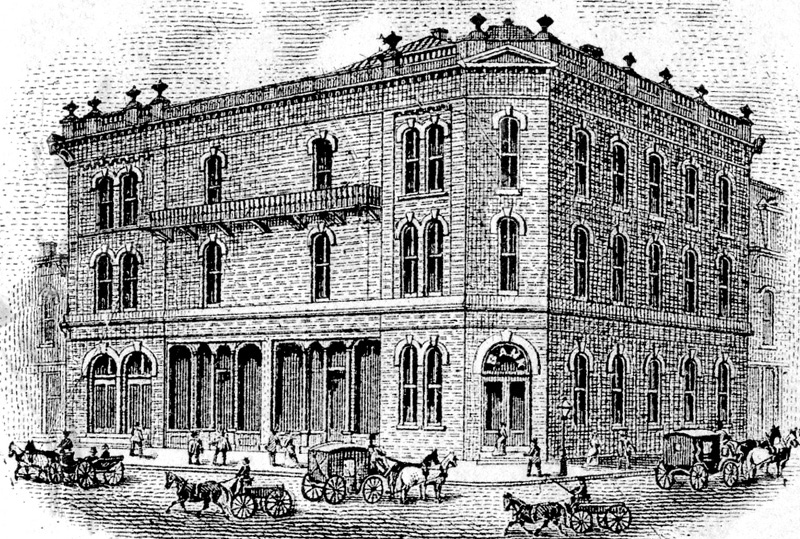
Erected
on a site opened when an 1872 fire destroyed the stylish Clinton House
hotel,
the Coldren Opera House pictured here represented the summit of cultural
life
in Iowa City for a quarter century. The image is from a 1900 bank certificate
of deposit.
|
By
Bob Hibbs
Known
during most of its era as “the Coldren,” the Grand Opera House shared a
downtown Iowa City building with the Iowa City State Bank during the last
quarter of the 19th century and early in the 20th century. The Opera Saloon
was next door.
The
nostalgic aura of both institutions is gone, although their home still exists
in dramatically-altered form as the Savings and Loan Building which occupies
the southeast quadrant of the Clinton-College streets intersection.
It
succeeded the Clinton House hotel after an 1872 fire destroyed the hotel,
considered the finest of its era. The Clinton was owned by local bankers
Ezekiel Clark and Thomas Hill, who also planned and built its successor.
The
new edifice was designed by Des Moines architect Robert Finkbine whose later
gift of land expanded the University of Iowa far westward and bore his name.
Its exterior has been refaced with limestone, the balcony removed and the
corner entrance to the bank closed over, giving today’s surviving structure
a sharply different appearance.
The
old-fashioned playhouse and its banking companion were recalled recently when
the author acquired a $25 certificate of deposit issued in 1900 by ICSB. It is
easily confused with today’s Iowa State Bank, but it has no connection, nor
any modern successor.
The
bank CD was redeemed in installments; first in the amount of $5, followed by
two of $10 each, the last paid May 15, 1900, just 27 days after the initial
deposit date.
No
interest rate is stated, nor is any specific duration, as is done on similar
instruments today. It clearly was payable on demand, although specifically
endorsed as “Not Subject To Check.” It was issued to Henry C. Johnson by
bank cashier R.A. Korab.
The
drawing published today appears as a postage-stamp-sized image in the top
right corner of that CD.
The
playhouse occupied the two floors above the bank from its completion during
1877 until the Coldren was closed in 1912, economically executed by advent of
motion pictures crowned by the opening of other venues, particularly UI’s
Macbride Hall in 1908 and a more modern playhouse, the Englert Theatre, in
1912.
In
addition to legitimate stage presentations, the Englert also offered motion
pictures.
The
Coldren name comes from its second owner, John Coldren who died in 1892. He
was a widely respected Johnson County sheriff from 1877 to 1882 who joined
Clark and Hill in banking. Son Stevens Coldren later established the
long-lived “Old Ladies’ Home” on Clark Street which bore his mother’s
name, Mary O. Coldren.
During
the 1890s more than 350 repertory shows played back and forth across America,
bringing entertainment to any community located along a railroad, including
Iowa City.
The
Coldren featured top performers of the era and housed such stellar local
events as the formal inaugurations of UI presidents, as well as commencements
and class plays.
A
long-remembered spoof of the UI faculty produced by students as an elaborate
burlesque at the Coldren featured a factious George Thrasher, a thinly-veiled
reference to UI’s fifth president, George Thacher, who served during the
1870s.
After
service for public events, the Coldren space was remodeled for use by the
Triangle Club, a private UI faculty group, until that club moved into new
quarters in the Iowa Memorial Union in April 1927.
Subsequent
renovations of the bank building, particularly one in 1940, produced its
modern incarnation which was named for First Federal Savings and Loan which
occupied the main floor from 1940 until 1981.
Like
nearly every local building of its time, the opera house suffered having
nearly every pane of glass in its many windows broken by the hail storm of 5
p.m. Saturday, May 5, 1894. The hail stones were reportedly three inches in
diameter.
Next
Saturday: Grand Wood, an Iowa City
institution. Bob
Hibbs collects local postcards and researches history related to them. |